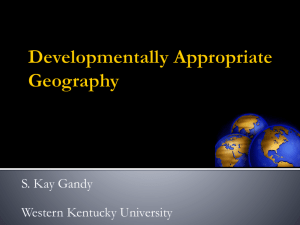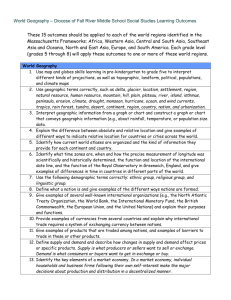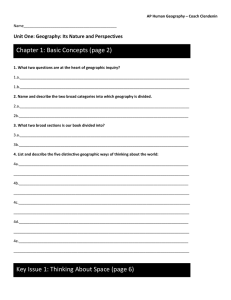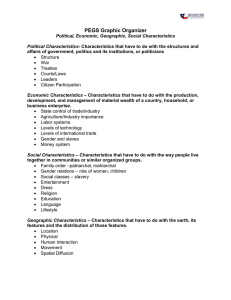Countries Around the World
advertisement
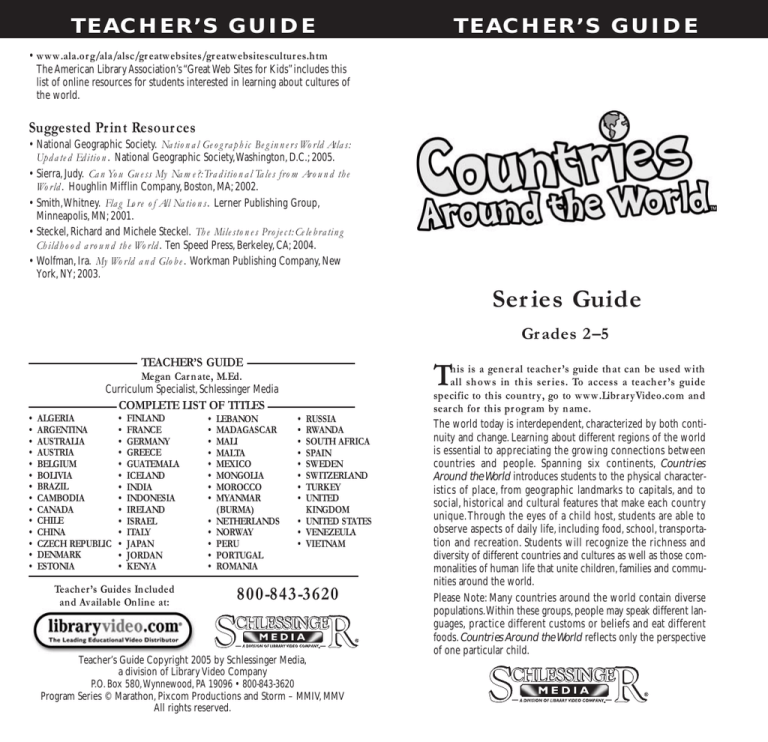
TEACHER’S GUIDE TEACHER’S GUIDE • www.ala.org/ala/alsc/greatwebsites/greatwebsitescultures.htm The American Library Association’s “Great Web Sites for Kids” includes this list of online resources for students interested in learning about cultures of the world. Suggested Print Resources • National Geographic Society. National Geographic Beginners World Atlas: Updated Edition. National Geographic Society,Washington, D.C.; 2005. • Sierra, Judy. Can You Guess My Name?: Traditional Tales from Around the World. Houghlin Mifflin Company, Boston, MA; 2002. • Smith,Whitney. Flag Lore of All Nations. Lerner Publishing Group, Minneapolis, MN; 2001. • Steckel, Richard and Michele Steckel. The Milestones Project: Celebrating Childhood around the World. Ten Speed Press, Berkeley, CA; 2004. • Wolfman, Ira. My World and Globe. Workman Publishing Company, New York, NY; 2003. Series Guide Grades 2–5 TEACHER’S GUIDE T Megan Carnate, M.Ed. Curriculum Specialist, Schlessinger Media COMPLETE LIST OF TITLES • ALGERIA • ARGENTINA • AUSTRALIA • AUSTRIA • BELGIUM • BOLIVIA • BRAZIL • CAMBODIA • CANADA • CHILE • CHINA • CZECH REPUBLIC • DENMARK • ESTONIA • FINLAND • FRANCE • GERMANY • GREECE • GUATEMALA • ICELAND • INDIA • INDONESIA • IRELAND • ISRAEL • ITALY • JAPAN • JORDAN • KENYA Teacher’s Guides Included and Available Online at: • LEBANON • MADAGASCAR • MALI • MALTA • MEXICO • MONGOLIA • MOROCCO • MYANMAR (BURMA) • NETHERLANDS • NORWAY • PERU • PORTUGAL • ROMANIA • RUSSIA • RWANDA • SOUTH AFRICA • SPAIN • SWEDEN • SWITZERLAND • TURKEY • UNITED KINGDOM • UNITED STATES • VENEZEULA • VIETNAM 800-843-3620 Teacher’s Guide Copyright 2005 by Schlessinger Media, a division of Library Video Company P.O. Box 580,Wynnewood, PA 19096 • 800-843-3620 Program Series © Marathon, Pixcom Productions and Storm – MMIV, MMV All rights reserved. his is a general teacher’s guide that can be used with all shows in this series. To access a teacher’s guide specific to this country, go to www.LibraryVideo.com and search for this program by name. The world today is interdependent, characterized by both continuity and change. Learning about different regions of the world is essential to appreciating the growing connections between countries and people. Spanning six continents, Countries Around the World introduces students to the physical characteristics of place, from geographic landmarks to capitals, and to social, historical and cultural features that make each country unique. Through the eyes of a child host, students are able to observe aspects of daily life, including food, school, transportation and recreation. Students will recognize the richness and diversity of different countries and cultures as well as those commonalities of human life that unite children, families and communities around the world. Please Note: Many countries around the world contain diverse populations.Within these groups, people may speak different languages, practice different customs or beliefs and eat different foods. Countries Around the World reflects only the perspective of one particular child. Vocabulary Terms relevant to the programs of this series are provided below: country — A formal geographic area with distinct boundaries that shares a political system. capital — A city that serves as the headquarters of its country’s government. culture — The language, holidays, traditions, religion, arts, skills, clothing, food and music of a particular group of people. currency — Any kind of money, such as coins or paper money, that is used as medium of exchange. economy — The way people make, sell and buy goods and services. geography — The study of the relationship between people and places. Geography includes the landforms, climate, vegetation, population and natural resources of a place. government — The people and groups who make, carry out and enforce rules and laws, and who manage disputes about them. religion — The belief system of a group of people. Previewing Discussion • As a class, brainstorm a list of questions about the country. Prompt students by asking,“If you could have lunch with a kid from this country, what would you want to ask him or her?” It may also be helpful to look at the country’s location on a world map. How might the country’s location impact the way of life there? • Just as there is diversity in your class, community and country, there is diversity in all the countries represented in this video series. It can be in culture, language, religion or just in personal preferences. Engage students in a discussion about the diversity that exists around them.Then, discuss the benefits and limitations of seeing one child’s view of his/her country.As students prepare to watch this program, invite them to be on the lookout for evidence of diversity and multiculturalism. • Introduce the idea of different points of view by asking students what they think about a particular place in the United States.As a class, explore where students got their information, asking,“Did you visit the place? Did you read about it? Do you know someone from there?” Discuss how point of view and perspective can affect descriptions of place and culture. • Remind students of the distinction between fact and opinion. Introduce the ideas of nationalism as a feeling of a common identity and patriotism as pride in one’s country.Ask students to think about how they would describe their country to a student from another country.What would be a fact? What would be an opinion? Discuss what impressions one might have after listening to the different descriptions. Follow-Up Discussion & Activities • As a class, generate a list of the things students have in common with the child host from this country.They may be surprised at some of the similarities they share. Have students design and write postcards to the program’s host. Highlight some of these similarities. Students can also point out some of the interesting differences in their lifestyles. (Continued) • The program’s host shared some interesting and unique aspects of life in his or her country.Ask students,“If you could make a video of life in your country, what would you show?”After brainstorming ideas, divide the class into groups. Have each group write a script and design props (from pictures of famous sites to pretend food) for this show. Each group can perform its show for the class. If possible, videotape the presentations. • Write and illustrate a class fact book about this country. Students can include facts about the country’s geography, history, culture, wildlife and people. Use reference and electronic material sources to gather additional information. • Turn an investigation of this country into a day-long class celebration! Invite guest speakers who have lived in, or visited, this country to speak to students. Play games that make up some of the country’s popular pastimes. Share folktales from its oral tradition. Introduce and practice saying helpful phrases in the country’s official language(s). Of course, sample some of the country’s cuisine.At the end of the day, students can reflect upon and write about some of the memorable elements of the country and its culture. • National symbols, like the flag and national anthem, can tell a lot about a country’s history and identity. Use information from the program as well as other reference sources to learn more about the national symbols of this country. Compare these symbols to those of the United States and other countries.What themes or ideas do they share? How do they differ? • Use clay, salt dough or another medium to create a raised relief map of this country.Advise students to sketch the country on a sturdy piece of cardboard first, keeping in mind the locations of bodies of water.When molding the dough or clay, be sure to show the locations of mountain ranges and other geographic landforms of the country.After the map dries, use paint or other craft materials to give greater detail to the map. Be sure to locate the country’s capital as well as some of the places visited by the host. • After watching this program, students may be interested in learning about neighboring countries or other countries that are similar on the basis of climate, geography, politics or religious beliefs.With 52 titles in the Countries Around the World series, there are many possibilities for further exploration. Use Venn diagrams, charts, webs and other graphic organizers to record information as well as to compare and contrast the characteristics of different countries. Suggested Internet Resources Periodically, Internet Resources are updated on our web site at www.LibraryVideo.com • www.kidlink.org/KIDPROJ/MCC/index.html The Multi-Cultural Calendar is a valuable resource for teachers and students interested in learning more about celebrations around the world. • plasma.nationalgeographic.com/mapmachine/ National Geographic’s Map Machine is a great source for all types of maps of the world, including road maps, physical maps and satellite maps. • www.countryreports.org/Index.aspx A great resource for teachers and students about the countries of the world with cultural, historical and statistical information. (Continued)

